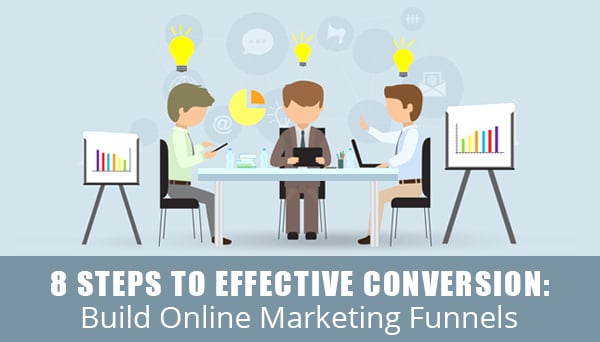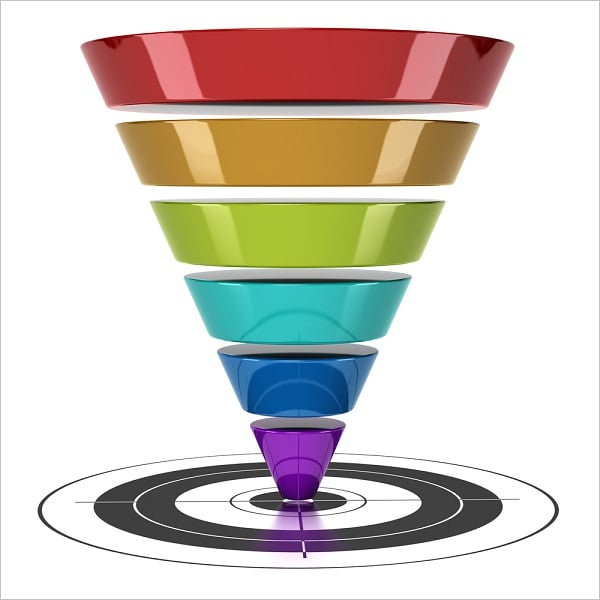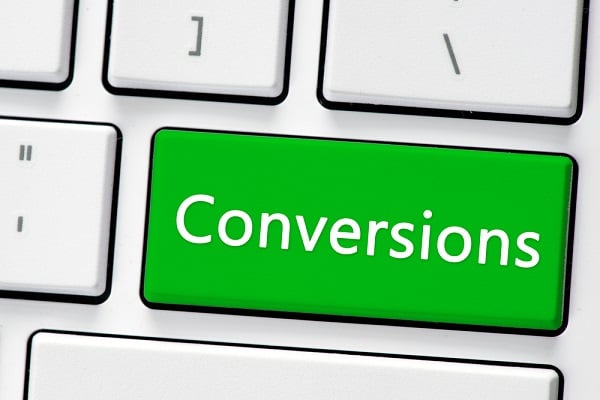8 Steps to Effective Conversion: Build Online Marketing Funnels
Successful conversion marketing requires a deep understanding of the conversion funnel and a sense of how the buyer transitions from the top to the bottom of a sale. When you build your funnel, try to walk in the shoes of the buyer through their purchasing journey. Here are eight steps to building and maintaining effective online marketing funnels.

1. Understand the Goal of a Conversion Funnel
Conversion marketing is precisely what the name implies — marketing dedicated to the pursuit of conversions (as opposed to email signups or page likes). The traditional conversion funnel is not really a funnel at all. If you pour water into the top of a funnel, all the water eventually makes it through the spout. Conversion funnels are inherently leaky. Potential buyers escape at every level until very few remain at the bottom. You aim to increase the number of people who make it from the top to the bottom.
An example for this is the Russell Brunson 5 day challenge.

Images courtesy of Shutterstock
2. Understand the Journey Down the Funnel
The basic sales conversion marketing funnel has four levels: awareness, interest, desire, and action. The top of the funnel, awareness, is home to vast numbers of raw, unqualified leads. The overwhelming majority of these leads will never convert. The next level is interest. The customers at this level are not just aware of your product but are also interested in it. Next is a desire for your product, which only some curious people will ever express. Finally, the last customers remaining at the bottom of the funnel are those who will take action or convert.
There are plenty of strategies and programs that can help you launch your first lead generation funnel. A good example of this is the Russell Brunson 5-day challenge.
3. Plug the Holes at Every Level
The funnel tightens first because not everyone who is aware of your brand will ever become interested. Not everyone who is interested will go on to desire your product, and not everyone who desires it will take action and convert. Your goal is to get more conversions, which means eliminating the reasons people exit the funnel. Funnels leak because of lousy landing pages, the wrong price point, inconsistent branding or any number of things. But in many cases, bounce rates can be attributed to inconsistent branding.
4. Build Templates So The Customer Experience is Consistent at Every Level
You must project your brand at every touchpoint so you don’t lose customers who aren’t sure they’re in the right place. Create reusable templates so you can remain consistent even when you make changes. This should include landing page templates and social media image templates, but branding should extend into the physical world. Create shipping label templates and business card templates, as well.
5. Build Awareness
Now that the foundation is in place, you must draw people into your funnel’s wide top by creating awareness. This is done by advertising directly to your target audience so you don’t draw the wrong people who are unlikely ever to convert.
6. Create Interest
With the top of your funnel full, you must gin up interest by creating compelling, informative, image-driven content that you cross-promote across channels. Post consistently so your audience gets in a pattern where they expect you to produce good content on a regular basis.
7. Turn Interest into Desire
Your audience is now aware and interested. Instill desire by communicating directly and responding to hashtags and @mentions. Answer questions, address problems, introduce the people behind the business, and convey value to potential buyers.

Image courtesy of Shutterstock
8. Get the Conversion!
This is the level that counts the most. Spur conversions by optimizing your landing pages with short, bold headlines, uncluttered layout, quality video, and obvious, enticing calls to action. Offer a free trial so they can convert without fear, and include a phone number to know they can reach someone if they ever need help.
Conversion is the last step on a long buyer journey. Focus on plugging the funnel at every level by nurturing your remaining customers at each point. Create templates, focus on your landing pages, and, most importantly, understand the journey down the funnel your buyers will take.

